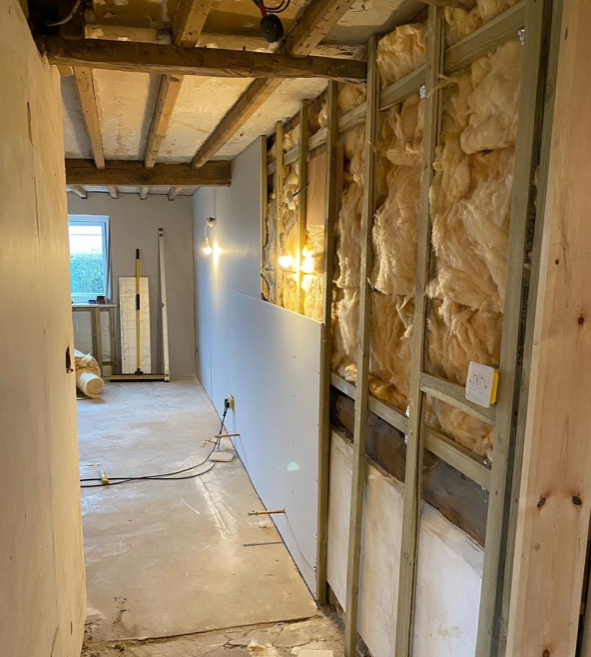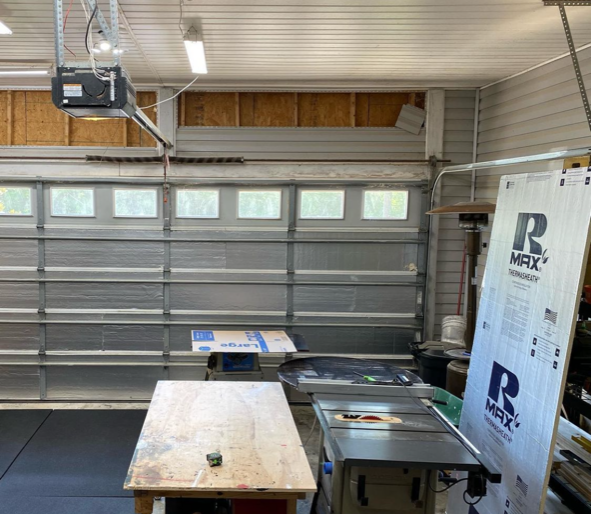How to insulate a garage
Whether you’re looking to expand the amount of living space you have, or you need a dedicated home office, insulation is key to making your garage comfortable all year round.
Many homeowners choose to improve their current property rather than move on. With increasing house prices, there’s never been a better time to start working on your own home, for example by refurbishing or converting your garage, than right now.
The first steps
The main thing to do before starting to insulate your garage is to take a step back and ensure your garage is ready to be insulated. This means giving it a good spring clean and making sure you’ve got easy access to the walls, roof, floors, and doors. This is also a good to start checking for signs of damp or other problems that may need to be addressed before work begins.
Once you have thoroughly checked over your garage, you
should then check the fit of the windows and doors to see if either of them is
letting in a draft. If they are, you may wish to replace them with insulated
doors and double-glazed windows. This is especially important if your garage is
going to become an office or new living space for your family.
Also remember to check the condition of the garage roof, which can be
particularly important for garages with flat roofs, as these are more
susceptible to issues such as leaks.
Checking your garage before insulating may be tedious and long-winded, but
it'll save you a lot of time, money, and frustration in the future.
You should also take this time to familiarise yourself with the UK building regulations, as extensive refurbishment work on properties normally requires a raise in overall insulation performance. So, it is always worth double checking with national and local regulations before getting started.

@renovating_with_l_plates
How to insulate garage walls
Most garages in the UK have walls that are made up of just a ‘single skin’ of breeze blocks. So, for these, you have several insulation options to choose from. However, if the condition of your garage’s walls is dissatisfactory, there is the option of deconstructing them, insulating the walls, and then rebuilding the wall. This is of course expensive and could be potentially troublesome, so only attempt to do it if necessary and you feel confident undertaking the job.
Internal wall insulation
The most tried and tested method is to construct a timber frame against the inside of the walls and install insulation slabs in between the sections of the timber frame.
External wall insulation
If your property features a detached garage, it may be wiser to opt for external wall insulation. This will involve fitting insulation boards and suitable render systems to the external walls. It may seem strange increasing the thickness of the outside of your garage, but the internal space savings could be well worth it.
How to insulate a garage roof
Choosing the right garage roof insulation for your property
will largely depend on whether your garage has a pitched or a flat roof.
Garages with pitched roofs can be insulated in a similar way as when fitting
loft insulation in your home. When it comes to garages with flat roofs, you
have the choice between constructing a warm roof or a cold roof.
Warm roof construction refers to flat roofs where the insulation materials are
fitted above the roof desk. This option is generally the most recommended route
to go down, as it maximises internal space by retaining your full
ceiling-to-floor height, all whilst keeping your roof deck warm and reducing
the risk of condensation build up.
As for cold roof construction, it is the name for flat roofs where the
insulation layer is below the roof deck. They are referred to as ‘cold roofs’
due to how any area above the insulation will be colder than the living space below. If you’re opting for a cold roof, we’d suggest
first screwing 50x50mm battens to the side of your rafters below the roof deck.
This will ensure that you maintain an air gap of 50mm.

@731woodworks
How to insulate a garage floor
Uninsulated garage floors can become incredibly cold, so
underfloor insulation is a must if you want your garage to be a viable living
space during the winter months. Insulation boards are a great way of achieving
that warm, welcoming feeling thanks to its fantastic performance, and its thin
design to ensure you’ll lose minimal space.
Once you’ve chosen the right garage floor insulation, there are a few more
things to consider. If you’d like to retain the concrete slab floor of your
garage, you should install a
damp-proof membrane before any insulation.
As well, can also choose to insulate your garage door. Although this is
optional, it makes a massive difference to the overall insulation of the
garage.
Whatever your plans are, making the right choice is vital. If you’re still unsure then get in touch with our customer service team on 01472 907051, or visit your local, friendly Howarth branch. They’ll be able to talk you through the pros and cons of each option and advise you which insulation is best for your needs.
Recent Posts
-
An Introduction to Types of Paving
There are so many different types of paving out there, but which ones are right for your project? Wh
-
10 small outdoor kitchen ideas just in time for summer
As summer approaches, many homeowners are looking for ways to enhance their outdoor living spaces&md

